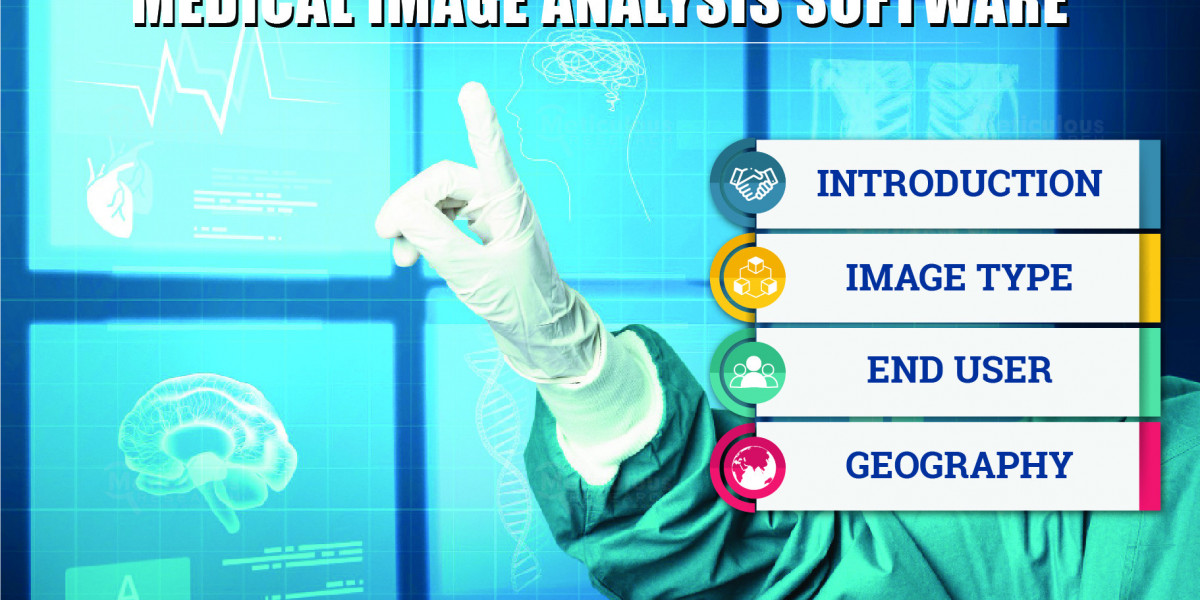The Role of AI in Medical Image Analysis
Integration of Artificial Intelligence: A Major Trend
The integration of Artificial Intelligence (AI) into medical image analysis software represents a key trend driving market growth. AI enhances medical image processing and analysis by employing sophisticated algorithms trained on vast amounts of medical data. These algorithms can identify specific anatomical markers in images from various modalities such as X-ray, ultrasound, MRI, and others. AI-enabled software offers several advantages:
Faster Patient Throughput: AI speeds up patient scheduling and reduces exam times.
· Improved Diagnostic Accuracy: AI provides clearer, sharper, and more detailed images, aiding in faster and more accurate diagnoses.
· High-Volume Image Processing: AI can process numerous images quickly, allowing healthcare professionals to make swift assessments.
· Many companies are integrating AI into their software to meet the growing demand for enhanced medical image analysis. For example, GE Healthcare unveiled around 60 innovative AI and digital technology solutions at the RSNA 2021 Annual Meeting, and Huiying Medical Technology Co., Ltd. developed an AI-based diagnostic solution for early-stage COVID-19 detection.
Market Segmentation and Key Findings
Integrated Software Segment: Leading the Market
In 2022, the integrated software segment is expected to account for the largest market share. Integrated software, pre-installed or designed for specific imaging systems, offers multiple applications such as acquisition, annotation, management, processing, and data sharing. Its benefits include:
· Cost-Effectiveness: Reduces overall costs by centralizing data storage.
· Ease of Access: Facilitates easy data access for single or multiple users.
· High Adoption Rates: Due to the widespread use of diagnostic imaging tools.
· Dominance of the 3D Image Segment
The 3D image segment is anticipated to dominate the market in 2022. 3D imaging provides clearer views of organs and tissues compared to 2D imaging, offering better visibility of angles, resolutions, and details. The high usage of 3D imaging equipment and the prevalence of chronic diseases contribute to this segment's large market share.
X-ray Imaging: A Key Market Segment
X-ray imaging is projected to hold the largest share of the medical image analysis software market in 2022. This modality uses electromagnetic waves to generate internal body images and is widely utilized for early diagnosis and clinical applications. The COVID-19 pandemic further increased demand for X-ray imaging to detect chest infections, bolstering this segment's growth.
Cardiology Segment: Significant Market Share
The cardiology segment is expected to account for the largest market share in 2022. The high prevalence of cardiovascular diseases (CVD) and the increasing demand for minimally invasive surgeries drive this segment's growth. According to the Centers for Disease Control and Prevention (CDC), about 697,000 people died from cardiovascular diseases in the U.S. in 2020, highlighting the need for advanced cardiovascular imaging.
Hospitals Segment: Leading End-User
In 2022, the hospitals segment is predicted to lead the market in terms of share. Hospitals perform a variety of imaging procedures crucial for clinical treatment planning and disease prevention. The segment's large share is due to the increasing number of hospitals in emerging markets and their high spending capabilities, which result in greater adoption of advanced imaging technologies.
Opportunities and Challenges in the Market
· Growth Opportunities
Emerging economies with developing healthcare infrastructure offer significant growth opportunities for market players. The increasing adoption of telemedicine and remote patient monitoring technologies further enhances the market potential. These advancements allow for efficient healthcare delivery and improved patient outcomes.
· Challenges
Despite the positive growth outlook, the market faces challenges such as high costs of advanced imaging systems and limited availability of skilled professionals. Addressing these challenges requires investment in training programs and cost-effective technological solutions.
Download PDF Brochure @ https://www.meticulousresearch.com/download-sample-report/cp_id=5383
Conclusion
The medical image analysis software market is on a trajectory of substantial growth, driven by advancements in AI, increasing prevalence of chronic diseases, and expanding healthcare infrastructure in emerging economies. With integrated software and AI-enabled solutions leading the way, the market is poised for significant developments. Companies investing in innovative technologies and addressing market challenges are well-positioned to capitalize on the growing demand for advanced medical imaging solutions.
Key Players
Key companies operating in the medical image analysis software market are Koninklijke Philips N.V. (Netherlands), Canon Inc. (Japan), GE HealthCare (U.S.), Siemens Healthineers AG (Germany), Agfa-Gevaert N.V. (Belgium), Carestream Health, Inc. (U.S.), AQUILAB SAS (France), Esaote S.p.A (Italy), MIM Software Inc. (U.S.), and Image Analysis, Ltd. (U.K.), (a subsidiary of IAG, Image Analysis Group (U.K.)).
Contact Us:
Meticulous Research®
Email- sales@meticulousresearch.com
Contact Sales- +1-646-781-8004
Connect with us on LinkedIn- https://www.linkedin.com/company/meticulous-research







